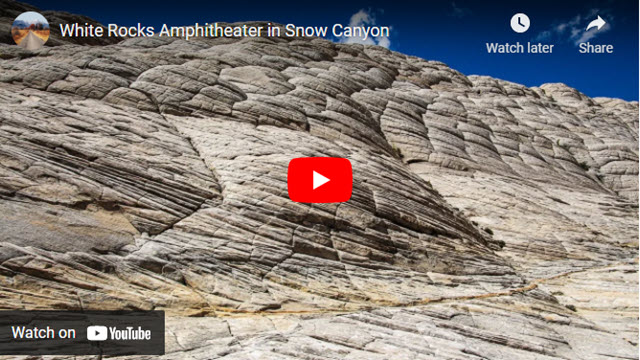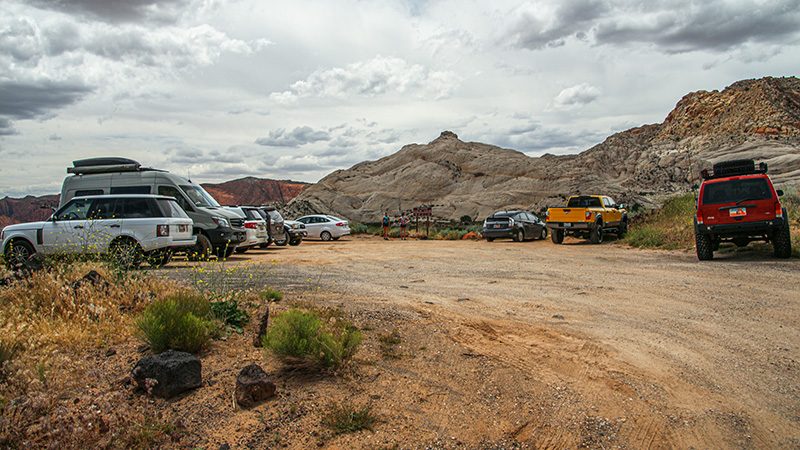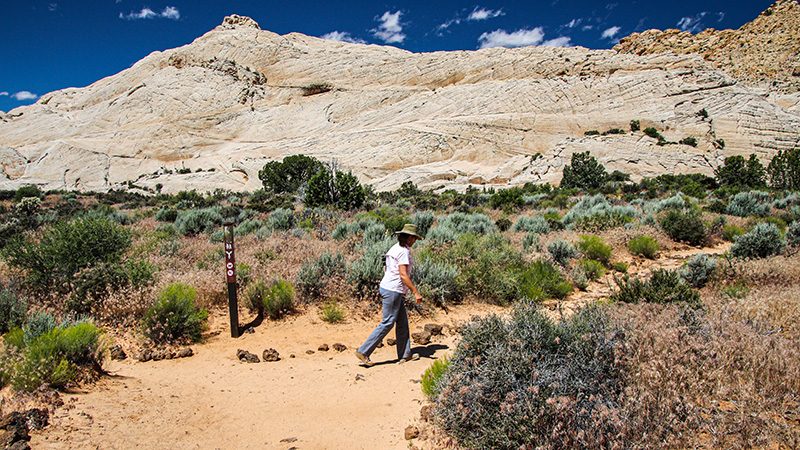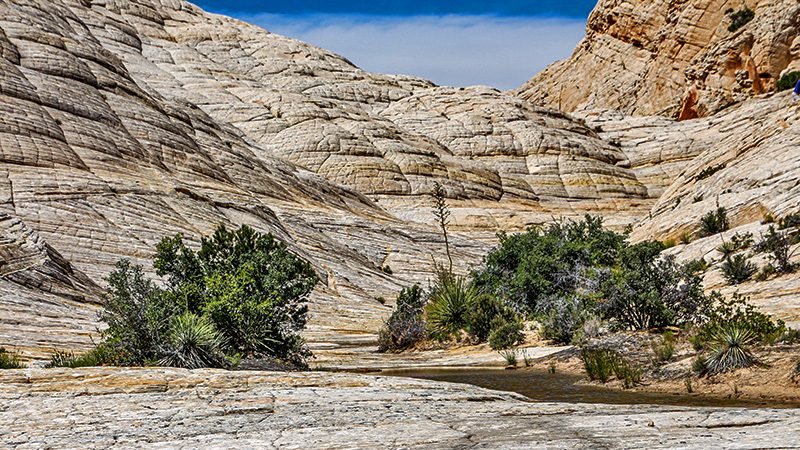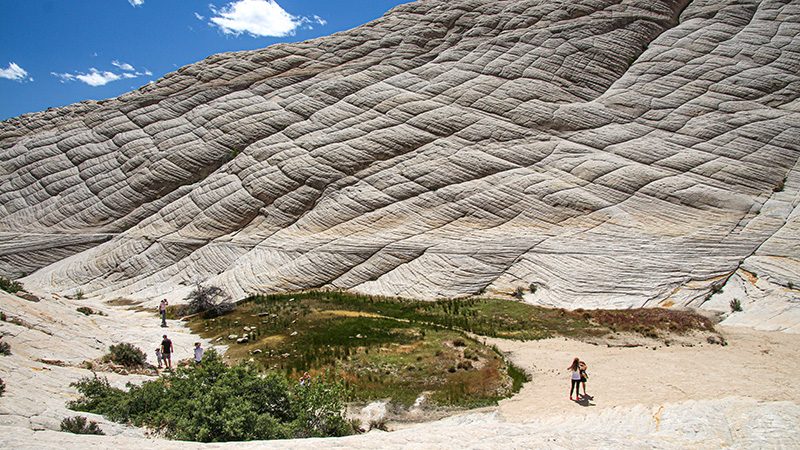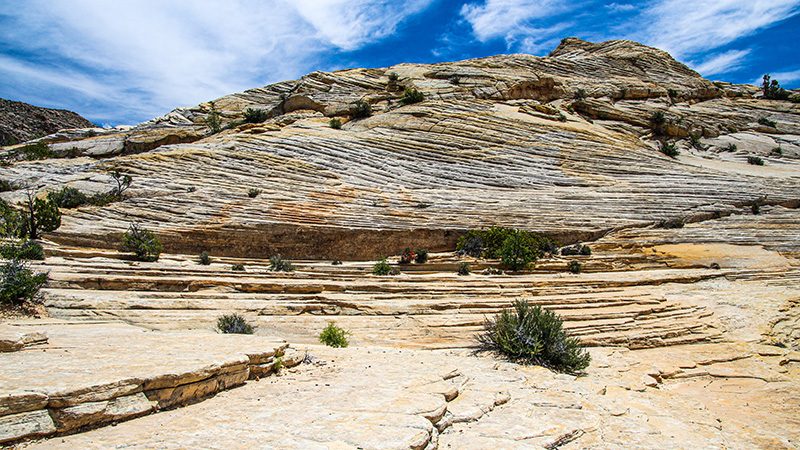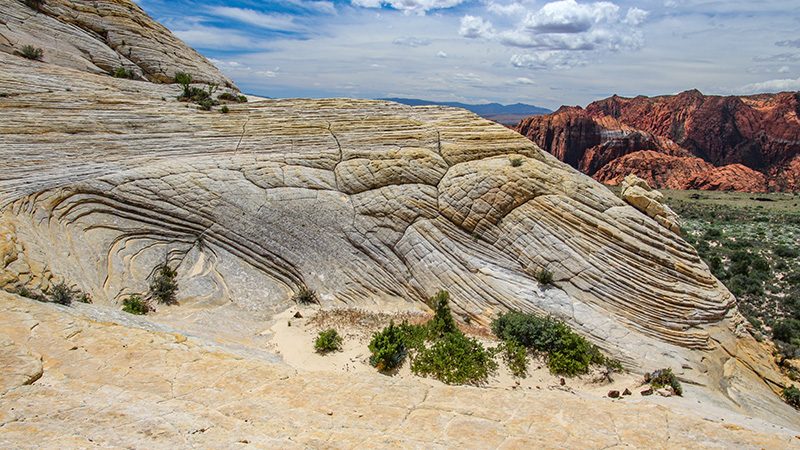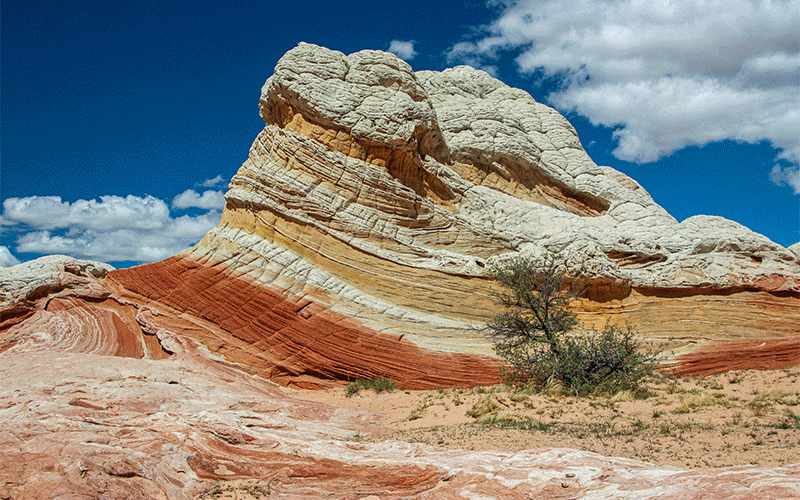White Rocks Amphitheater in Snow Canyon
Snow Canyon State Park, situated next to St. George, Utah, offers a variety of colorful rock formations and the White Rocks Amphitheater is part of that collection. Many people think of southern Utah as the home of red rocks (which it is) so don’t let the name White Rocks keep you away. What it may lack in color, it makes up for in texture, elegance and beauty. This area has some of the finest examples of petrified sand dunes and angular cross-bedding in Southern Utah. It is impressive!ean.
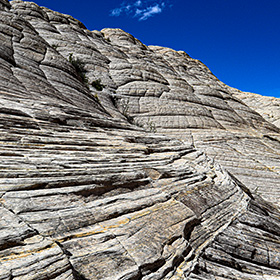
Hike Summary
The White Rocks Amphitheater is found in the northern section of Snow Canyon. It is easy to find from the pavement and easy to access on foot. The amphitheater itself is reached following a well-marked hiking trail about a half-mile long. Once you’ve had your fill of the swirling sandstone of White Rocks Amphitheater, another short trail takes you to a sprawling overlook of Snow Canyon itself. Here you will be able to see examples of both the white and red Navajo Sandstone. If you hike to both the amphitheater and the overlook, the round-trip total distance is about 1.6 miles on mostly level ground.
We visited in May and there was still several ponds left from water runoff from recent rains. In the fall, most likely there will be no water. Winter and spring would be ideal times to visit White Rocks. The hot days of summer would be too hot as there is no shade and the hiking trail to the amphitheater passes over black lava rock.
Getting There
Get to the White Rocks Amphitheater trailhead by first getting yourself to St. George via I-15. Exit at Bluff Street (Hwy 18) and head north for 11.5 miles. Look for the northern entrance to Snow Canyon State Park on your left and drive in to the entrance station to pay your fee. Turn around when it is safe to do so, go back to Hwy 18 and turn left. Just a half mile past the entrance, the parking area for the trailhead will be on your left. Park here.
The Hike
The trail heads west towards the white sandstone. You can make out the amphitheater’s entrance in the distance – watch our virtual video tour for a clue. In just over a quarter mile, a trail junction is reached. Turn right to continue to the amphitheater. You will return to this junction later and continue to the left (heading south now) to the overlook of Snow Canyon.
After the junction, in less than a quarter of a mile, you’ll reach the entrance to the amphitheater. The trail ends with a sign pointing to the left and up to White Rocks Amphitheater. From here on, you must navigate your own way over a sea of swirling sandstone. But don’t worry about losing your way because the path is fairly obvious.
From the trail’s end, you will climb a short, steep segment of sandstone. After the climb, look ahead and you will realize why it’s called an amphitheater. You first walk through a somewhat narrow entrance with the swirling sandstone on both sides of you. Walking further, the amphitheater opens up into a very large bowl. If you visit White Rocks Amphitheater during the winter or spring months like we did, you might be rewarded with several pools of water that beautifully reflect the curvy rock formations. One of the pools was created by a small dam.
How White Rocks got its name is pretty obvious but you may not know that this rock mass is made up of Navajo Sandstone. The swirling appearance was created by layers and layers of sand that was moved and shifted by ancient winds during the Jurassic Period of about 195 million years ago. The sand became petrified and left the wonderful patterns and textures you see today. Geologists call this phenomenon “angular cross-bedding”.
Navajo Sandstone is one of the most significant and thickest formations or layers making up the Colorado Plateau and adjoining areas. There’s more to explain about this amazing piece of the geologic jigsaw puzzle and how it influenced this part of the Southwest but we’ll save that for another article and tour.
What’s especially interesting about the Navajo Sandstone in this area is that, in Snow Canyon, it can be found in two different colors – red and white. It seems the red sandstone sits at the bottom of the formation and the white sits on top. There are numerous theories as to how this one formation (the same type of sandstone) developed two colors. Most of the theories involve rust (iron oxide) and how water that percolated through the sandstone might have made it red (rusted). What you’ll see on this hike is mostly white.
Past the pool with the small dam is another steep climb. After climbing this short section, you will be amazed to find small sand dunes with various cacti growing in the sand. The sand here came from the eroding of the surrounding sandstone – going back into its original state. Turn left to take in a view through a large crack peering down into Snow Canyon proper.
You might feel compelled to climb the sandstone walls on the south side of the amphitheater. Since the sandstone is porous, hiking shoes will grip it very well and aid your ascent. Climbing the sandstone is an interesting experience. If you climb all the way to the top, you will certainly have an outstanding view.
More…
Pictures
Below are some pictures of what you will see along the way.
The Overlook
Once you’re done with the amphitheater, retrace your steps all the way back to that trail junction. Here, turn right, which is south, and walk another third of a mile to the overlook that gives a great view into the top section of Snow Canyon and the expansive red and white Navajo Sandstone that shapes the canyon. At this overlook area are some more beautiful swirling sandstone formations.
The overlook is the end of our hike so, once again, retrace your steps back to the trail junction, turn right, and return to the trailhead. While walking back, notice how the black volcanic basalt rock that spewed out of the cinder cone just up Hwy 18 from the trailhead is in sharp contrast with the white sandstone. This contrast in rock colors is what Snow Canyon is famous for.
Happy Exploring!
Trip Map
Support Us
Help us fill up our tank with gas for our next trip by donating $5 and we’ll bring you back more quality virtual tours of our trips!
Your credit card payment is safe and easy using PayPal. Click the [Donate] button to get started:
